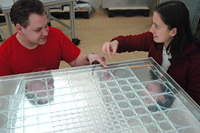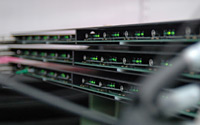 |
|||||||||||
|
|||||||||||
|
|||||||||||
In a tent in a test hall at DESY in Hamburg, Germany, the hadron calorimeter is learning how to see. This calorimeter - an essential part in all proposed detector designs for the ILC - measures the energy of all those particles that make it through the dense electromagnetic calorimeter. It does this with the help of scintillators, small plastic plates where incoming particles interact, leaving information of their energies, a fibre that changes the photons' wavelengths from ultraviolet to green, and tiny photodetectors that convert the light into an electronic signal. Hadrons interact with layers of dense metal, producing the charged particles whose signal is measured and conclusions can be drawn on the energy and nature of the hadron that swooshed past. So far nothing new, hadron calorimeters have been used in particle detectors for a long time. This one, however, is special. "At the ILC, we want to be able to reconstruct every single particle that is created in the collision of the electron-positron beams," explains Erika Garutti, an Italian physicist working on the detector part's prototype at DESY. "To be able to see possible new physics we need extremely good eyes. We also need very small eyes to distinguish all the details. This system will be unprecedented in its granularity and precision," says Erika. This hadron calorimeter prototype is part of the CALICE project ("CAlorimeter for the LInear Collider Experiment"). About 200 physicists from 32 institutes in nine countries are working on it. Soon they will be able to do so without leaving their desks: Their project is the first to try out an e-log system developed by the TESLA Technology collaboration that will allow remote access from all over the world to check the status and change the controls of the system. The control room of the future?
Six layers of the calorimeter, each consisting of two centimetres of steel and a thin and shiny layer of scintillators, detectors and cables, have already been built and tested. By July half the prototype, 18 to 20 layers approximately, will be stuck in a test beam at CERN. This is needed for correct understanding and calibration of the detector. For Erika Garutti, this is part of the fun: "We need the prototype to study the physics because at the moment there is no data with the precision we need." First results from earlier and smaller prototypes shows that the technology works well. By October 2006, the complete electromagnetic and 40-layer hadron calorimeter will be tested, and these tests will be repeated at Fermilab the following year. The prototype will be about 1 m^3 in size. The complete hadron calorimeter part of the final detector for the ILC will be 120 times as big and will contain about 5 million of the photodetectors of silicon photomultipliers (SiPM) ("They count single photons!" beams Garutti). This design was originally developed for the 'Large Detector Concept', which started with the TESLA proposal. Two other proposed detector concepts are an even larger array with a different magnetic system (GLD) and a much more compact silicon detector, SiD. CALICE's hadron calorimeter fits all other concepts, so every assembled layer and every minute in the electron test beam is a step towards the final design. -- Barbara Warmbein |
|||||||||||
| © International Linear Collider |

